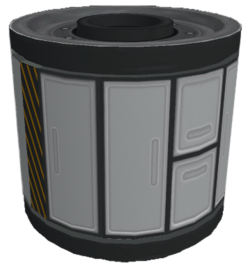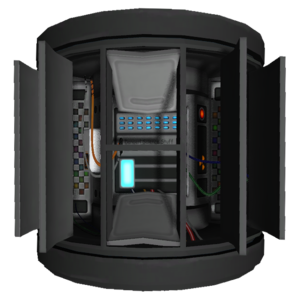Difference between revisions of "SC-9001 Science Jr."
From Kerbal Space Program Wiki
m (-version template usage and link directly;) |
m |
||
| (12 intermediate revisions by 8 users not shown) | |||
| Line 1: | Line 1: | ||
{{:SC-9001 Science Jr./Box}} | {{:SC-9001 Science Jr./Box}} | ||
| − | The '''SC-9001 Science Jr.''' (also called the Material Bay or Materials Bay) is used to retrieve [[science]] points and to complete science experiments in space or other celestial bodies. In [[career|career mode]], it is available with [[Science | + | The '''SC-9001 Science Jr.''' (also called the Material Bay or Materials Bay) is used to retrieve [[science]] points and to complete science experiments in space or other celestial bodies. In [[career|career mode]], it is available with [[Basic Science]], at level 4 of the [[technology tree]]. |
== Usage == | == Usage == | ||
[[File:SC-9001 interior.png|thumb|left|The interior]] | [[File:SC-9001 interior.png|thumb|left|The interior]] | ||
| − | It is the more advanced<!-- = later in the tech tree --> scientific [[sensor]] added with {{version|0.22}}. The unit cannot be reused after its results were transmitted, unless it is cleaned by the [[Mobile Processing Lab MPL-LG-2]]. | + | It is the more advanced<!-- = later in the tech tree --> scientific [[sensor]] added with {{version|0.22}}. The unit cannot be reused after its results were transmitted, unless it is cleaned by the [[Mobile Processing Lab MPL-LG-2]] or a [[Kerbal experience|kerbal scientist]]. |
| − | The measurements are only [[biome]] specific if on the surface. At all other altitude | + | The measurements are only [[biome]] specific if on the surface. At all other altitude segments, the measurements are always the same over the complete segment. It can gather science at all altitudes and environments. |
== Product description == | == Product description == | ||
| − | {{Quote|The SC-9001 is a cutting edge, self contained laboratory. Have you ever wondered what happens to something in zero G? Or, have you ever pondered the truly meaningful questions? Such as what would happen if I exposed this to the rigors of stellar radiation and unforgiving vacuum? | + | {{Quote|The SC-9001 is a cutting edge, self-contained laboratory. Have you ever wondered what happens to something in zero-G? Or, have you ever pondered the truly meaningful questions? Such as what would happen if I exposed this to the rigors of stellar radiation and unforgiving vacuum? It comes with complimentary notepad. Recommended for ages 4-8. Small parts inside make it not suitable for small children. |
| + | |Experimental Engineering Group}} | ||
== Trivia == | == Trivia == | ||
*If the part is used in sandbox mode, the data message says "I don't think we are getting much done here", etc. | *If the part is used in sandbox mode, the data message says "I don't think we are getting much done here", etc. | ||
| − | *The number 9001 in the name is a reference to [[w:HAL 9000|HAL 9000]] from [[w:2001: A Space Odyssey (film)|2001: A Space Odyssey]]. This is supported by the report obtained when observing the module while high over Jool. Moreover, by zooming on the activated module, there is a red light that looks like HAL's red dot.<!-- image request --> It is not a reference to the "over 9000" meme from Dragon Ball Z.<!-- is this only based on the report? --> | + | *The number 9001 in the name is a reference to [[w:HAL 9000|HAL 9000]] from [[w:2001: A Space Odyssey (film)|2001: A Space Odyssey]]. This is supported by the report obtained when observing the module while high over Jool, while landed on Dres, and while landed on Duna. Moreover, by zooming on the activated module, there is a red light that looks like HAL's red dot.<!-- image request --> It is not a reference to the "over 9000" meme from Dragon Ball Z.<!-- is this only based on the report? --><!-- Yes, plus the picture --> |
| + | |||
| + | *The part is used to capture the [[Deep Space Kraken|Kraken]] In the "Kerbal Science" trailer for version 0.22. | ||
| + | |||
| + | *Keeping in line with other early science parts, the Science Jr. is most likely a paint-mixing kit, as shown by many of the experiment flavor-text messages (mid-flight and space over [[Kerbin]] being two prime examples). | ||
== Changes == | == Changes == | ||
| + | ;[[1.2]] | ||
| + | * Changed tech from Engineering 101 to Basic Science. | ||
| + | * Changed costs. | ||
;[[0.22]] | ;[[0.22]] | ||
* Initial release | * Initial release | ||
| Line 24: | Line 32: | ||
{{Parts}} | {{Parts}} | ||
[[Category:Environmental sensors]] | [[Category:Environmental sensors]] | ||
| + | [[Category:Science]] | ||
Latest revision as of 23:12, 26 May 2024
| SC-9001 Science Jr. | ||
| Environmental sensor by Experimental Engineering Group | ||
| Radial size | Small, Radial mounted | |
| Cost | (total) | 1 800.00 |
| Mass | (total) | 0.200 t |
| Drag | 0.3-0.2 | |
| Max. Temp. | 1200 K | |
| Impact Tolerance | 6 m/s | |
| Research | | |
| Unlock cost | 5 500 | |
| Since version | 0.22 | |
| Part configuration | materialBay.cfg | |
| Experiment | Materials Study | |
| Collectable | Yes | |
| Rerunnable | No | |
| Resettable | Yes | |
| Electricity required | None | |
| Packed volume | 2000 l | |
The SC-9001 Science Jr. (also called the Material Bay or Materials Bay) is used to retrieve science points and to complete science experiments in space or other celestial bodies. In career mode, it is available with Basic Science, at level 4 of the technology tree.
Contents
Usage
It is the more advanced scientific sensor added with version 0.22. The unit cannot be reused after its results were transmitted, unless it is cleaned by the Mobile Processing Lab MPL-LG-2 or a kerbal scientist.
The measurements are only biome specific if on the surface. At all other altitude segments, the measurements are always the same over the complete segment. It can gather science at all altitudes and environments.
Product description
| “ | The SC-9001 is a cutting edge, self-contained laboratory. Have you ever wondered what happens to something in zero-G? Or, have you ever pondered the truly meaningful questions? Such as what would happen if I exposed this to the rigors of stellar radiation and unforgiving vacuum? It comes with complimentary notepad. Recommended for ages 4-8. Small parts inside make it not suitable for small children. — Experimental Engineering Group |
” |
Trivia
- If the part is used in sandbox mode, the data message says "I don't think we are getting much done here", etc.
- The number 9001 in the name is a reference to HAL 9000 from 2001: A Space Odyssey. This is supported by the report obtained when observing the module while high over Jool, while landed on Dres, and while landed on Duna. Moreover, by zooming on the activated module, there is a red light that looks like HAL's red dot. It is not a reference to the "over 9000" meme from Dragon Ball Z.
- The part is used to capture the Kraken In the "Kerbal Science" trailer for version 0.22.
- Keeping in line with other early science parts, the Science Jr. is most likely a paint-mixing kit, as shown by many of the experiment flavor-text messages (mid-flight and space over Kerbin being two prime examples).
Changes
- Changed tech from Engineering 101 to Basic Science.
- Changed costs.
- Initial release

